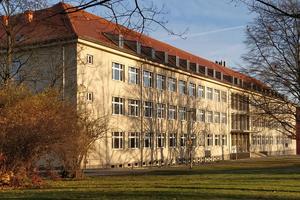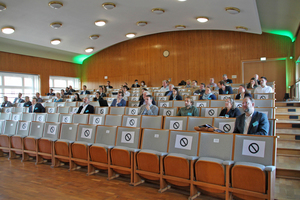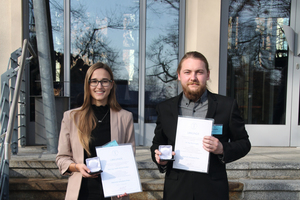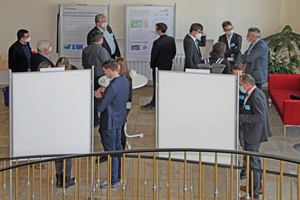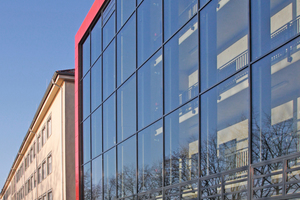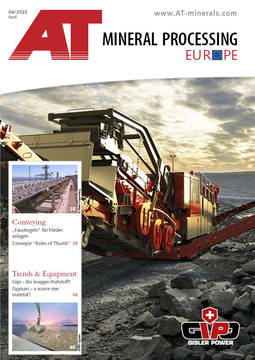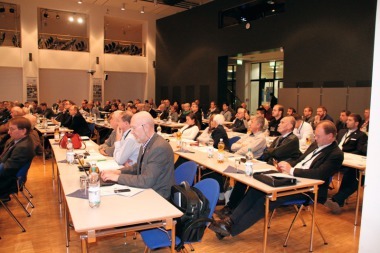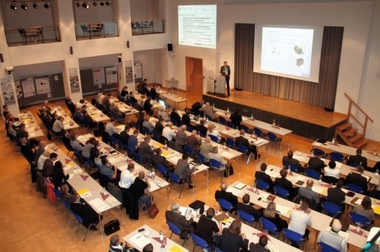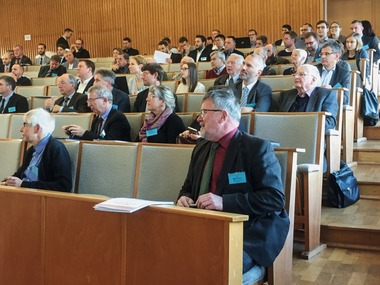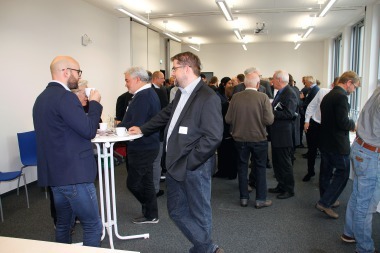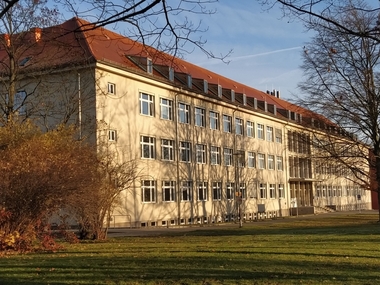Freiberg Conference “Processing and Recycling”
Dr Henning Morgenroth, one of the two managing directors of UVR-FIA GmbH, opened the conference with a short presentation of the company and an overview of the current fields of work and research. Directly after this, Dr Morgenroth kicked off the series of papers on the first day with a report on the “Processing Raw Kaolin”. With reference to a case study, he explained what tests must be conducted on the raw material kaolin to assess the potential and quality of the raw material in a deposit. Dr Morgenroth then outlined the individual process steps for the production of quartz or glass sand and kaolin products, such as washing, screening and hydrosizing, attrition, density sorting as well as primarily high-gradient magnetic separation.
“Optimal Ultrafine Sand Recovery – AKA-SILT System” was the subject of the paper by Robert Claussnitzer, AKW Apparate + Verfahren GmbH. To maximize the recovery of fine sand in the size range 0 – 150 µm and to reduce the load on sludge sedimentation ponds, AKW Apparate + Verfahren GmbH has developed the AKA-SILT System as a customized technical solution, which for the fine and ultrafine range combines hydrocycloning with dewatering of critical sand material and can be installed as an additional unit in existing plants.
After the first block of papers, the Heinrich Schubert Prize was presented by Prof. Dr.-Ing. Tobias Fieback, Dean of the Faculty of Machine Engineering, Process and Energy Engineering at Freiberg University of Mining and Technology, to Dipl.-Ing. Judith Miriam Friebel and Dr.-Ing. Paul Knüpfer. With regard to their subject and method, the ground-breaking diploma and doctoral theses were both in tradition of the work of Prof. Heinrich Schubert.
In her diploma thesis on the subject of “Quantitative Determination of the Concentration Profile of the Separated Impurity in a Precoat Filter Cake with the help of X-Ray Computer Tomography”, Judith Miriam Friebel had addressed the phantom method to identify specific particle concentrations in a matrix and conducted valuable preliminary work for a research project.
In his thesis on the subject of the “Agglomeration of Hydrophobic Particles in Aqueous Phases”, Dr.-Ing. Paul Knüpfer has, within the framework of Special Research Area SFB 920 (Multifunctional Filters for Metal Melt Filtration), successfully applied a model from natural sciences to particle technology in mineral processing and researched interaction mechanisms during the agglomeration of very fine particles, especially of non-metallic inclusions in metal melts.
Following the presentation of the two award-winning research projects, five short presentations were given by the poster exhibitors; there was ample time during the coffee break in the afternoon to view and discuss the posters:
Ultrahigh Temperature Sensors based on Boron Carbide Composites presented by Dr Bing Feng, Fraunhofer Institute for Ceramic Technologies and Systems IKTS (other authors: Dr Hans-Peter Martin and Prof. Alexander Michaelis, both also from IKTS)
DIGISORT and LOWVOLMON – parts of the greenBatt cluster, presented by Alexandra Kaas and Christian Wilke, Institute of Mechanical Process Engineering and Mineral Processing – MVT/AT, Freiberg University of Mining and Technology (other author: Urs A. Peuker, also MVT/AT)
Developing Methods to Tackle Analytical Challenges in Battery Recycling Materials using Automated SEM and Bulk Analytical Methods presented by Dr Kai Bachmann, ERZLABOR Advanced Solutions GmbH and HZDR-HIF (Helmholtz Institute Freiberg for Resource Technology) (other authors: Anna Vanderbruggen and Doreen Ebert, both also ERZLABOR and HZDR/HIF, and Robert Möckel, HZDR/HIF)
Increasing Raw Materials Efficiency with the Use of Waste Material Streams from Sink Erosion for Additive Manufacturing Processes, presented by Dipl.-Ing. Oliver Voigt, Institute of Mechanical Process Engineering and Mineral Processing – MVT/AT, Freiberg University of Mining and Technology (other author: Urs A. Peuker, also MVT/AT)
Mechanical Processes for Electrolyser Recycling, presented by Dipl.-Ing. Martin Brünner, Institute of Mechanical Process Engineering and Mineral Processing – MVT/AT, Freiberg University of Mining and Technology (other authors: Dipl.-Ing. Malena Staudacher and Dipl.-Ing. Carlo Kaiser, both also from MVT/AT)
After the lunch break on the first day of papers, attention turned away from primary resources, as the focus of this conference was clearly on the processing of secondary resources and recycling processes. Magdalena Heibeck, HZDR – HIF, reported on the “Experimental and Numerical Investigation of Liberation Comminution of Multi-Material Structures to Assess their Recyclability”. Objective of this research work was to create a digital model to enable the assessment of recyclability already during product creation process. An increasing number of products consists of multi-material structures. For this reason, it is important for the sustainable establishment of recycling solutions to get the product manufacturers on board to gauge the influence of design decisions on the liberation behaviour and to collect experience in the creation of an end-to-end digital chain from design through manufacturing to recycling.
“Processing of Mineral Composites” was the focus of the paper by Raphael Sperberg, Gebr. Jehmlich GmbH, and Thomas Rösener, Schock GmbH. They presented a joint project on a process that was implemented with a tailor-made plant in the industrial process at Schock GmbH.
Patric Van der Haegen, Eberhard Unternehmungen, reported in his paper “EbiMIK, the Turning Point in Construction Materials Recycling” on a new process for processing mixed demolition waste. In August 2021, operation was started up at a processing centre erected for this purpose in which a house pre-comminuted to 1 x 1 m can be sorted into individual components. From these, homogeneous secondary raw materials with defined properties can be produced. Besides concrete granulate, light minerals, gypsum, ferrous metals, non-ferrous metals, wood, plastic, etc. can be recovered separately. With the new process, quality building materials can be produced that are equivalent to primary construction materials, that is the value of the primary construction materials can be recycled and the value fully preserved in the cycle.
In his paper on the “Potential Applications of Laser-induced Breakdown Spectroscopy (LIBS) in the Processing of Ores and Industrial Minerals and in the Recycling of Building Materials”, Eckhard Zeiger, SECOPTA analytics GmbH, presented the industrial implementation of different LIBS systems and explained their functions and potential applications in steelworks, mining and recycling. The SECOPTA systems are in 24/7 operation and as such they are ideally suited for perfect process control, for instance in the monitoring of quality parameters, mix-up avoidance, production of controlled blends, trendspotting and also in recycling applications.
“Recovery of Gallium from Production Waste from the Semiconductor Industry” was the subject of the paper by Frank Haubrich, G.E.O.S. Ingenieurgesellschaft mbH. Against the background of a rising demand for gallium arsenide (GaAs)-based LEDs and gallium nitride (GaN) for power and optoelectronic components and for MSMA technologies in the future, separate processing technologies were developed for gallium-containing waste in the joint project EcoGaIN. They enable the recycling of gallium as well as the accessory substances arsenic and silicic acid back into the production process in the semiconductor industry. The developed technologies have already been integrated in the production cycle of the companies involved in the joint project.
In his paper “Salt Slag Processing – Technical, Economic and Legal Aspects” Robert Gerhard Merker, MMP (Mineral Resources, Consulting, Processing, Recycling, Project Support), presented the current situation of aluminium salt slag processing as an important element in the strictly controlled process chain of aluminium recycling. The focus here was the concept of full recycling in respect of technical, economic and legal challenges as well as with a view to unused potential – e.g. in relation to the recycling or utilization of hydrogen produced in the form of green hydrogen as an energy source of the future as well as methane.
In his paper “With Laser OES from Post-Mortem Process Control to In-Situ Process Management“, Alexander Schlemminger, QuantoLux GmbH, presented optimization potential for this measurement process. With this process, for analysis of heterogeneous materials, a large quantity of data can be created continuously and in situ – a key precondition for AI and simulation-based optimization measures, for instance, in kiln control in the cement industry or in steelmaking. With over 10 000 measured values per minute, such a large quantity of data is created that, for example, in steelmaking the homogenization of physical samples of slag composition after completion of treatment in a submerged arc furnace can be largely replaced by the homogenization of data during the melting process. On the basis of these precise analysis values, other production and processing processes can be very precisely adjusted in situ.
The second day of the conference was devoted exclusively to different aspects of recycling of lithium-ion batteries (LIB). LIB are now an integral part of our everyday life – be it in smartphones, notebooks, digital cameras, tools, or home electronics. Especially against the background of electromobility, the demand for LIB will continue to rise rapidly, with the result that on account of their limited lifetime, an ever greater quantity of spent batteries will be produced. This makes battery recycling one of the key technologies to recover the raw materials contained in LIBs – e.g. lithium, cobalt, nickel, manganese, copper, tin, graphite, aluminium and to make these available to the value creation chain.
Dr Hans-Georg Jäckel, Institute of Mineral Processing Machines and Recycling Systems Technology (IART) at Freiberg University of Mining and Technology, addressed in his paper for the “Concept on Thermal Pre-Treatment of Li Battery Cells for Electromobility Applications” the problems association with the mechanical processing of Li batteries. The electrolyte components (solvent, conducting salts, additives) contained in the batteries evaporate at ambient temperature and form flammable mixtures with the ambient air. Up until now, these highly flammable solvents have been removed during continuous operation of the processing plant, which has resulted in high requirements for fire and explosion protection, especially for the encapsulation of the relevant parts of the plant. The new decentralized approach of IART is aimed at removing especially the easily evaporated solvents (< 30 °C) in a low-temperature pre-treatment already before actual processing. In his paper, Dr Jäckel presented the results of initial tests in a laboratory-scale set-up.
Challenges and results for the “Production and Processing of a Black Mass Fraction of Lithium-Ion Batteries” were the focus of the paper by Tony Lyon, Institute of Mechanical Process Engineering and Mineral Processing (MVT/AT) at Freiberg University of Mining and Technology. During the mechanical processing of the LIB, after liberation of the batteries, amongst other things the active materials contained in the coatings of the anode and cathode foils are concentrated. Besides the main constituents, that is graphite and lithium mixed oxide, this so-called black mass also contains additives, binder components, the remains of the electrolytes including the conducting salt and its degradation products and impurities, e.g. copper. With the help of selectively applied sorting methods – magnetic separation, heterocoagulation separation or separation according to density – the individual materials can be separated from each other on the basis of their different physical properties. Goal is a purity of the material concentrates of almost 100 %, so that these can be reused.
Johanna Köthe, Institute of Mineral and Waste Processing, Waste Disposal and Geomechanics (IFAD) at Clausthal University of Technology, reported in her paper entitled “Development of Hydrometallurgical Recycling Processes for Lithium-Ion Batteries at IFAD at TU Clausthal”, on a number of projects that have been conducted since the 2000s in cooperation with companies and universities. They looked at pyrometallurgical and hydrometallurgical recycling routes – always with provision for the changing components of the different cell generations. At the focus of the total of seven research projects in which the IFAD is currently actively involved is the development of recycling processes as part of circular battery production. Of these, the speaker highlighted four conducted as part of the greenBatt cluster of Germany’s Federal Ministry for Education and Research, which concern the processing of slags from the pyrometallurgical route (PyroLith project), the processing of black mass from a mechanical pre-treatment to leaching (LOWVOLMON project), the refining of leaching solutions to produce metal salts with battery-grade quality (EVanBatter project) and the recycling of solid-state batteries (S2taR).
Latest investigation findings on “Processing the Black Mass of Lithium-Ion Batteries by Means of Magnetic Separation” were presented by Stephan Stuhr, UVR-FIA GmbH, Freiberg. The investigations were conducted with a pyrolyzed black mass with the active materials NMC (Li(NiMnCo)O2), LCO (LiCoO2) and graphite. During pyrolysis as the thermal deactivation process, carbothermal reduction takes place between the active materials and, with the use of graphite, the pyrolysis products NiO, MnO, CoO and metallic Ni and Co are formed. Based on the scale of magnetic susceptibility (separation characteristic), NMC, NiO, MnO and CoO can be classified as weakly magnetic, metallic Ni and Co as highly magnetic, while graphite and LCO as non-magnetic. By means of wet magnetic separation, it was possible to produce a graphite concentrate with a recyclable content of 95 – 97 mass% carbon with a recyclable yield of the carbon of 60 – 80 % – and therefore to successfully combat the loss of graphite usual in this process.
In the paper “The COOL Process – a Selective Process for Integrated Recycling of Lithium-Ion Batteries” by Robert Mende, Institute of Chemical Technology at Freiberg University of Mining and Technology, the focus was on the processing of black masses of different composition, with the goal of the complete mobilization of lithium. With the help of a selective leaching with supercritical CO2 in water, besides lithium, a significant part of the contained aluminium could be mobilized, while the recyclable metals also contained remain in the solid residue and can be further processed. With the process presented, it could be shown that it is possible to produce waste-derived secondary resources with primary product quality – e.g. lithium carbonate (Li2CO3) – as high-quality starting materials for industry.
The focus of recycling is currently more on the valuable metals like cobalt, nickel and lithium, while other components such as electrolyte, separator or graphite tend to be lost. To get closer to the goal of a recycling economy, to close the raw materials cycle, it is necessary to develop new and more comprehensive LIB recycling processes. Against this background, Martin Rudolph, HZDR – HIF, Freiberg, showed in his paper on “Latest Findings on the Flotative Processing of Black Mass and Developments in Black Mass Characterization with the Methods of Process Mineralogy and Liberation Analysis” how far and under which conditions a more efficient separation of graphite and lithium metal oxides can be achieved in black mass processing with the use of flotation.
In the last paper of the conference, Philipp Engels, Institute of Machine Tools and Production Technology (IWF) Chair of Sustainable Manufacturing & Life Cycle Engineering, Braunschweig University of Technology, reported on the “Importance of Graphite Recycling from the Perspective of Lifecycle Assessment”. On account of its outstanding conductivity, graphite is an essential anode material for lithium ion batteries and therefore one of the key raw materials for electromobility. The production of natural graphite contributes to greenhouse gas emissions. If it were possible to establish an efficient recycling process for graphite, this would have a positive influence on the lifecycle assessment and would, on the other hand, reduce the raw material dependence on countries like, for example, China. In this connection, Engels presented the ongoing research project “ecoLiga – Recycling and Resynthesis of Carbon Materials from Lithium Batteries: Recovery, Processing, Reuse and Adapted Cell Design”. This project, in which, amongst others, the IWF is involved with an accompanying sustainability assessment of the processes, addresses the possibility of the mobilization of battery components to close material cycles and access the carbon materials on the basis of a design for recycling.
To conclude the conference, as in past years, the attendees were given the opportunity to view UVR-FIA GmbH with Dr Henning Morgenroth, and, guided by Dr Martin Rudolph, also the Helmholtz-Institut Freiberg for Resources Technology (HIF) – here in particular they were able to tour the Metallurgy Test Centre opened in September 2021.
The next “Processing and Recycling” Conference is scheduled to take place on 10 and 11 November 2022. Papers can be submitted up to 31 July. Further information is available at https://www.uvr-fia.de/tagungsinformationen/.

